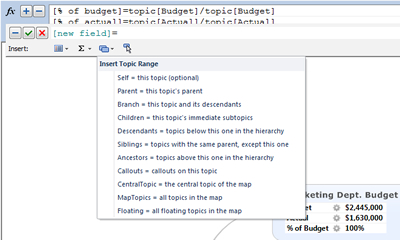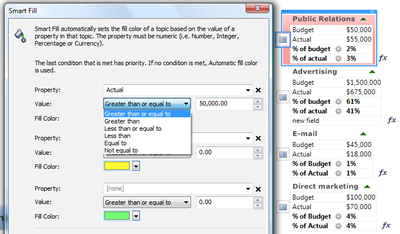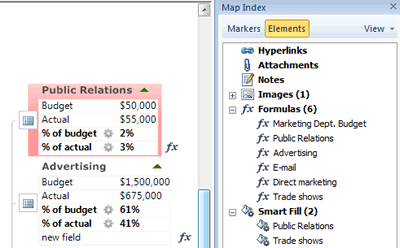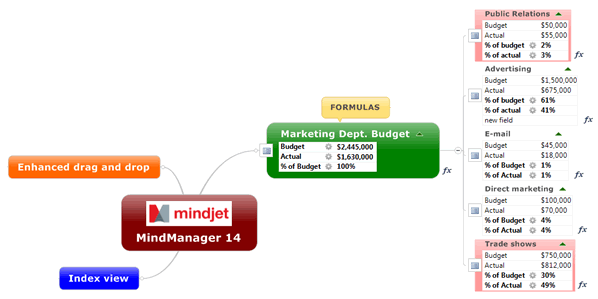MindManager 14 is quite possibly the most significant upgrade to this popular mind mapping software program ever, thanks to its new support for formulas and conditional formatting. Here is my review of this new version of Mindjet’s popular program.
The addition of formulas and conditional formatting to the latest version of MindManager opens up new possibilities for forecasting, budgeting and a host of other financial and mathematical calculations once reserved for Microsoft Excel. Conditional formatting is where MindManager 14 really shines, however. Imagine a topic that changes color when one or more of its numerical values are out of the range of the business rules you’ve set up. This transforms it into a true information dashboard, enabling you to manage by exception, visually alerting you to conditions to which you need to pay attention.
Under the hood, MindManager 14 offers a host of improvements, most notably a new index view, which makes it easy to find specific elements in large mind maps, and support for seven different types of drag and drop functionality.
Formulas: Excellent for budgeting, forecasting and other sophisticated analyses
The last version of MindManager contained support for adding numerical values to topics and rolling them up – totaling the values of each child topic and placing the value of their sum in the parent topic – but it didn’t support true formulas, like you’d use in an Excel spreadsheet. MindManager 14’s new formulas can be used for everything from simple addition to complex mathematical expressions.
The YouTube video below does an excellent job of providing an overview of the functionality of formulas in MindManager 14:
[youtube _MB-hNoEaAU nolink]
If you don’t feel comfortable writing formulas or haven’t used them in Excel, Mindjet conveniently provides a “wizard” that helps you quickly set up basic formulas and insert the necessary properties fields into the parent and child topics.
 If you want to “roll your own” formulas, MindManager 14 provides a series of buttons and drop-down menus enable you to configure formulas, step by step; once you understand the syntax it uses, you can also type formulas into the program directly. The interface that makes this possible is modeled after Microsoft Excel.
If you want to “roll your own” formulas, MindManager 14 provides a series of buttons and drop-down menus enable you to configure formulas, step by step; once you understand the syntax it uses, you can also type formulas into the program directly. The interface that makes this possible is modeled after Microsoft Excel.
For doing things like summing the values of a group of child topics and placing them in a parent topic, the formula writer and wizard work very well. But if you want to do something special, like calculate percentages (as in my example in the screen shot at the top of this page), it’s not easy or intuitive to figure out. The program’s help file provides some basic background information about formulas, but didn’t address my scenario. I struggled with creating formulas for about 45 minutes before I finally figured it out.
Mindjet wisely designed the functionality of formulas to support “what if” analysis. In part, that’s because it enables you to be very specific about which topics it should include and exclude in its calculations. In the formula builder, one of the drop-down menus gives you these options:
- Children – This topic’s immediate subtopics
- Siblings – topics with the same parent, except this one
- Ancestors – Topics above this one in the hierarchy
- Callouts – Callouts on this topic
- Floating – All floating topics in the map
What this enables is a scenario like this: Let’s say you’re working on a budget with 10 line items, represented by 10 sibling topics. You want to see how the overall budget will be affected by the addition of a new type of expense. So you set it up as a floating topic with appropriate data. In the parent topic, you create a formula that sums the values of a particular field name, but only in sibling topics. That means it’s not counting the value of the 11th line item in the floating topic. The minute you drag and drop it and attach it to the parent topic, however, the map immediately recalculates the sum to include it. Drag it away from the parent to transform it back into a floating topic, and the formula recalculates the total without it.
How can you use such unique functionality? Through a series of “what if” experiments, you can determine the perfect mix of projects and their estimated costs that will fit within your department’s budget, for example. Or you can do a risk analysis on a group of potential projects and once again, figure out what your perfect portfolio should be, based on calculations of estimated cost and other criteria.
Conditional formatting
 Conditional formatting is where MindManager’s formula tool really stands out. Besides enabling you to do sophisticated calculations, it can change the color of the topic based upon its value, a capability Mindjet calls this “Smart Fill.” One way you can use it is to show that an actual line item expense is greater than the amount you budgeted. You can do this via the Smart Fill dialog box shown at right.
Conditional formatting is where MindManager’s formula tool really stands out. Besides enabling you to do sophisticated calculations, it can change the color of the topic based upon its value, a capability Mindjet calls this “Smart Fill.” One way you can use it is to show that an actual line item expense is greater than the amount you budgeted. You can do this via the Smart Fill dialog box shown at right.
An example of that is the trade show topic at the top of this page. I simply created a conditional format that says if the actual property is equal to or greater than $750,000, then color the topic red. This enables you to create more meaningful information dashboards that help you to manage by exception, only looking for items that are outside of the business rules you have set up.
In its initial implementation, conditional formatting lets you set up three different colors and six different conditions (greater than or equal to, greater than, less than or equal to, less than, equal to and not equal to), which lets you do a lot. You can also chain together up to three conditions. But one area that I thought was a bit restrictive is that the value you specify must be an integer, which you must input into the Smart Fill dialog box. Using my budget example above, I couldn’t point to the budget figure within the properties of “public relations” and say, color this topic red if the value exceeds the number contained in that property. What if I changed the value of it? Then I would have to go back into Smart Fill and change its condition to this new absolute value.
In the bigger picture, this is a minor shortcoming. The whole idea of conditional formatting is quite cool, and I commend Mindjet for including it in MindManager 14. I must remember that it will probably improve over time. If Mindjet devotes some programming muscle to this functionality, it could eventually do some even more powerful things!
Index: Help for finding small things within big mind maps
 To help users of MindManager 14 navigate and work with large, complex mind maps, Mindjet has debuted a new view called the index, which now shares a pane on the right of the workspace with the marker view. You’ll notice I said elements, not topics. I want to make that distinction because several competing mind mapping programs already offer an index view, but they display all of your map’s topics in a collapsible and expandable outline view. Mindjet takes a different tack, focusing instead on the types of elements that make up your mind map – including hyperlinks, attachments, notes, topic properties and more – and enabling you to zero in on them as groups of objects within your maps.
To help users of MindManager 14 navigate and work with large, complex mind maps, Mindjet has debuted a new view called the index, which now shares a pane on the right of the workspace with the marker view. You’ll notice I said elements, not topics. I want to make that distinction because several competing mind mapping programs already offer an index view, but they display all of your map’s topics in a collapsible and expandable outline view. Mindjet takes a different tack, focusing instead on the types of elements that make up your mind map – including hyperlinks, attachments, notes, topic properties and more – and enabling you to zero in on them as groups of objects within your maps.
Hovering over an element in index view causes a thumbnail view of it to pop up, so you can more easily see what it is. Clicking on an element in index view takes you to that location within your mind map. A drop-down “view” menu lets you filter the list of elements, which helps you reduce visual clutter in this view. It also enables you to sort what’s displayed in this pane either in the order in which it appears in your mind map or in alphabetical order. Mindjet says index view acts like a “pivot view” of your large mind maps.
Improved drag and drop
MindManager 14 now includes seven new types of drag and drop functionality, enabling you to add assets to your mind map faster. This includes not only images, but also e-mail, calendar and task items from Outlook, Mindjet’s collaborative online workspace and the program and more. It gives you a lot of flexibility in how to add assets to your map. For example, dragging and dropping an image into your map causes a dialog box to pop up, asking if you want to insert it as an image, a hyperlink or an attachment. Similarly, if you want to consolidate your notes in a mind map and drag and drop one note on top of another one, the program asks you if you want to replace or append its contents.
Competing programs have supported adding images and other assets to mind maps via drag and drop for some time now. It’s nice to see Mindjet finally addressing this omission. I didn’t use drag and drop all that much in the past. But now that I’ve become accustomed to working with two large screens, I’ve discovered that I prefer to keep MindManager open in one and Windows Explorer in the other, and to drag and drop images and files to my maps.
Conclusion
MindManager 14 is a significant step forward for this mature mind mapping program. The addition of formulas makes it an even more potent planning tool. Mindjet has equipped with with a very powerful, flexible toolset for adding calculations to your mind map, and then utilizing conditional formatting to give you visual feedback when the numbers are outside of the norms you have set up. But as we’ve seen, these capabilities are still a bit rough around the edges.
When I received a briefing from Mindjet’s Michael Deutsch that covered these capabilities of MindManager 14, I sensed that many of its users may need some help understanding the capabilities of formulas and conditional formatting, so they can unlock its full potential. He assured me that the company plans to hold a series of webinars that will meet this training need.
MindManager 14 for Windows is US$349 and is available from the Mindjet website. A MindManager Plus option, which gives you perpetual upgrades and access to a Mindjet web account, is US$129 per year. A trial version is also available for download.


Leave a Reply